#bio fertilisers
Text
जानिए, क्यों अनुपम है बायोचार (Biochar) यानी मिट्टी को उपजाऊ बनाने की घरेलू और वैज्ञानिक विधि?
मिट्टी की सेहत सँवारने वाला, सबसे सस्ता और आसानी से बनने वाला टॉनिक है बायोचार
बायोचार के इस्तेमाल से मिट्टी के गुणों में सुधार का सीधा असर फसल और उपज में नज़र आता है। इससे किसानों की रासायनिक खाद पर निर्भरता और खेती की लागत घटती है। लिहाज़ा, बायोचार को किसानों की आमदनी बढ़ाने का आसान और अहम ज़रिया माना गया है।


हरित क्रान्ति में भले ही रासायनिक खाद और कीटनाशकों की अहम भूमिका रही हो, लेकिन ये निर्विवाद है कि इससे भूमि की उर्वरा शक्ति का पतन और पर्यावरण प्रदूषित हुआ। इसीलिए विकसित देशों में रासायनिक उपायों को अपनाकर उपजायी गयी फसलों से सख़्त परहेज़ करना शुरू कर दिया। दरअसल, रासायनिक उपायों ने मिट्टी की उत्पादकता को टिकाऊ नहीं बनाया। तभी तो इसकी ज़रूरत हमेशा पड़ने लगी।
रसायनों के दुष्प्रभाव से बचने के लिए जहाँ एक ओर परम्परागत, प्राकृतिक या जैविक खेती की ओर लौटने पर ज़ोर दिया जाने लगा, वहीं ऐसे प्राकृतिक उपायों को पहचानने की ज़रूरत थी जो किसान और पर्यावरण, सभी के अनुकूल हो।
इन्हीं उद्देश्यों की तलाश में वैज्ञानिकों ने बीती सदी के सातवें दशक में ये साबित किया कि मिट्टी में कार्बनिक पदार्थों की प्रचुरता से ही उसकी उर्वरा शक्ति क़ायम रह सकती है, क्योंकि इन्हीं कार्बनिक पदार्थों से मिट्टी में उसे उपजाऊ बनाने वाले उन सूक्ष्म जीवों की मात्रा बढ़ती है जो अन्ततः फसल को पोषक तत्व मुहैया करवाते हैं। इन्हीं चुनौतियों से उबरने के लिए वैज्ञानिकों ने ‘बायोचार’ विकसित किया जो सही मायने में ‘हींग लगे न फिटकरी, रंग भी चोखा होय’ जैसा उपाय है।
बायोचार बनाने से धरती पर मौजूद अथाह बायोमास का भी बेहतरीन इस्तेमाल हो जाता है और पर्यावरण संरक्षण में मदद मिलती है। क्योंकि बायोमास के अपघटन या सड़ने से भारी मात्रा में जहरीली ग्रीनहाउस गैसें वायुमंडल में घुलती हैं और ‘ग्लोबल वार्मिंग’ का सबब बनती हैं।
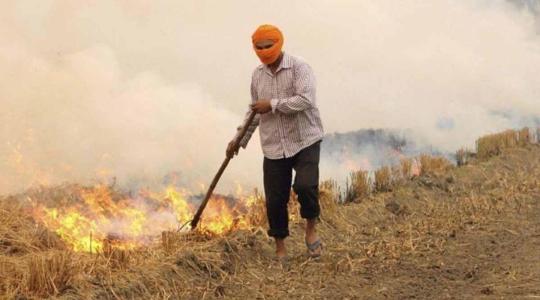

क्या है बायोचार?
बायोचार यानी ‘जैविक चारकोल’ का नाता ‘बायो फ़र्टिलाइज़र’ और ‘चारकोल’ से है। बायोचार, एक बेहद सस्ती, घरेलू और वैज्ञानिक तकनीक है जिससे किसी भी तरह की मिट्टी के उपजाऊपन को दशकों और यहाँ तक कि सदियों के लिए बढ़ाया जा सकता है। दरअसल, मिट्टी प्राकृतिक रूप से लगातार पोषक तत्व प्रदान करने वाले सूक्ष्म जीवों को ‘बायोफ़र्टिलाइज़र’ कहते हैं और कार्बन की अत्यधिक मात्रा वाले पदार्थ या लकड़ी के कोयले को ‘चारकोल’ कहते हैं�� दोनों शब्दों के शुरुआती अक्षरों ‘बायो’ और ‘चार’ को जोड़ने से ‘बायोचार’ (बायो+चार) शब्द बना है।
और पढ़ें.......
0 notes
Link
IFFCO Bio-decomposer is composed of a group of beneficial micro-organisms, which rapidly convert crop residues, animal waste, dung and other waste into organic manure. For more - bio fertilisers
0 notes
Link
#bio-ethanol#biofuel#centrifugal#chemical#chemicalpump#fertiliser#lifecyclecosts#metal#metallurgy#paper#process#processpump#pulp#Sulzer#TCO
0 notes
Link
Fungi, bacteria, nematodes, viroids, phytoplasmas, and viruses cause plant diseases. These plant pathogens mainly live on foliage as well as soil. These pathogens have adapted well to the environment, some even have a protective covering that can last for over two years.
0 notes
Text
The new 'compost obligatoire' rules came into force on 1 January 2024. Here's what they entail.
As of 1 January 2024, organic waste recycling is mandatory in France under new 'compost obligatoire' rules.
With support from the government’s Green Fund, municipalities must provide residents with ways to sort bio-waste, which includes food scraps, vegetable peels, expired food and garden waste.
Households and businesses are required to dispose of organic matter either in a dedicated small bin for home collection or at a municipal collection point. Previously, only those who generated over five tonnes of organic waste per year were required to separate it.
The waste will then be turned into biogas or compost to replace chemical fertilisers. Alternatively, it can be composted at home.
The obligation is currently on local authorities to provide an easy means for households to compost or separate organic waste.
While facilities are rolled out, there will not be fines imposed for non-compliance. It is yet to be seen whether stricter rules will be imposed in future.
One-third of household waste is bio-waste
Organic waste from food and gardens accounts for almost one-third of household waste. When it is mixed with other rubbish, it typically ends up in landfills or incinerators, where it produces heat-trapping greenhouse gases like methane and CO2.
Food waste is responsible for about 16 per cent of the total emissions from the EU food system, according to the European Commission. Globally, food loss and waste generates around 8 per cent of all human-caused emissions annually, the UN says.
It can also contaminate packaging destined for recycling like paper, plastic and glass.
In 2018, only 34 per cent of the EU’s total bio-waste was collected, leaving 40 million tonnes of potential soil nutrients to be discarded, according to NGO Zero Waste Europe.
In France, an estimated 82 kg of compostable waste per person is thrown away each year.
Is bio-waste separation mandatory in other European countries?
Under the EU’s Waste Framework Directive, bio-waste collection is being encouraged this year, but it stops short of setting mandatory targets.
In many European countries, organic waste separation has already been implemented at the municipal level.
Milan in Italy has been running a residential food waste collection programme since 2014. Households were given dedicated bins and compostable bags to kick off the scheme.
Elsewhere, taxes or bans on incinerating bio-waste have encouraged similar schemes, with separate bins and home composting widespread in Austria, the Netherlands and Belgium.
The UK announced plans to roll out separate food waste collection in 2023. It remains voluntary for households in England, but is more strictly enforced in Wales and for business owners.
How to sort your bio-waste
Ideally, all waste - including organic matter - should be kept to a minimum.
This can be achieved through careful meal planning. Consuming, freezing or preserving food before it expires along with using every part of an ingredient also help to reduce waste. Some food waste can even be repurposed into animal feed.
Any food waste that cannot be saved or repurposed should be either composted or separated for collection. This includes uneaten food scraps, baked goods, dairy products, eggshells, fruit and vegetables and their peels, mouldy food, pet food, raw and cooked meat and fish, bones, tea and coffee grounds.
Liquids, non-food products and packaging should not be placed in bio-waste bins.
-via EuroNews.Green, January 2, 2024
#france#composting#eu#european union#organic waste#biofuels#recycling#sustainability#food#food waste#compost#carbon dioxide#carbon emissions#sustainable living#good news#hope
175 notes
·
View notes
Text
The construction industry is looking for a silver bullet to enable it to carry on as normal, swapping in one material for another. Hans Joachim Schellnhuber has argued that if construction over the next couple of centuries substituted business‑as‑usual materials such as steel and concrete for engineered timber, the atmosphere could return to pre‑industrial conditions. Engineered timber is now being heralded as the answer to all our industry’s problems, without much careful interrogation or contextualisation. While a shift to bio‑based materials is necessary, it is just as crucial to ask how these materials will be cultivated: where, on whose land, using what resources, and at what cost? The use of plants in buildings is necessarily intertwined with questions of sustainable cultivation, climate resilience, industrial agriculture, and the deployment of petrochemical‑fuelled fertiliser and pesticide inputs. The world’s ecosystems have shown us time and again that what landscapes need is diversity, and hectares and hectares of monocultural agriculture or woodland is neither resilient nor sustainable.
Summer Islam, Planting a seed: bio-based building
138 notes
·
View notes
Text
Nishidake Household: Chapter 5, Part 1
In this part the Nishidake household hit a few roadbumps with the inclusion of the health mods.
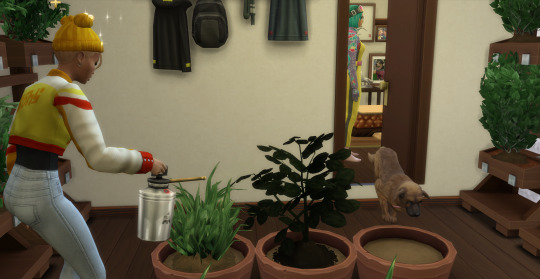
Back to Mt Komorebi where the Nishidake household sleeps. Last rotation they got the news that Kaori’s grandparents had left a large inheritance for her and her wife. The Nishidake family are the guardians of the mountain, a mantle which requires loyalty to the region. Specifically you can go somewhere on holiday, but if you take steps to move away you will die. At least according to a bunch of dead ancestors who tried, including Kaori’s parents.
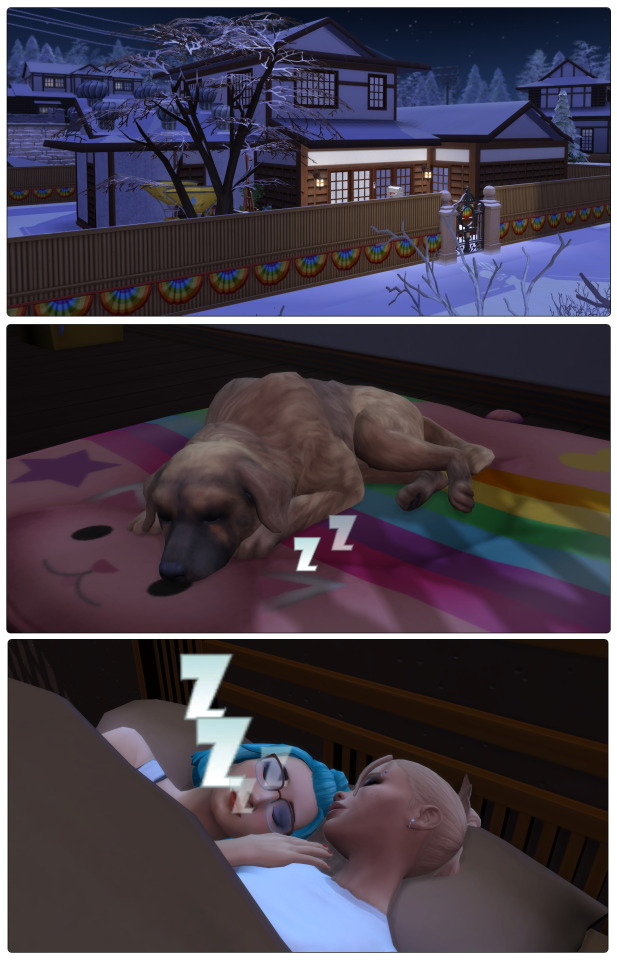
Charlie: We better get up
Kaori: Clover’s belly is not the boss of us
Clover: *barks hungrily*
Kaori: Who am I kidding? Her belly is totally the boss of us
Charlie: *laughs* I can go feed her if you want first shower
Kaori: Please. I had a not great fall yesterday and my muscles are still aching
Charlie: You should have said, I could have given you a massage
Kaori: I’ve maxed my snowboarding skill, I’m not meant to have falls
Charlie: Everyone has falls *to Clover* Come on my honey pie, who wants biscuits?

Charlie: Did you get back in your pyjamas? *kisses cheek*
Kaori: Yeah, they’re comfy
Charlie: Remember we need to go to the doctors first thing
Kaori: Why? Since when
Charlie: Mum text about a new mod. Apparently we need vaccines and to go see a gynaecologist
Kaori: Char only one of us got a bio degree
Charlie: Oh, they just look at our pixel parts and tell us if we’re healthy
Kaori: What? I don’t want some stranger looking at my pixel parts
Charlie: We don’t have a choice
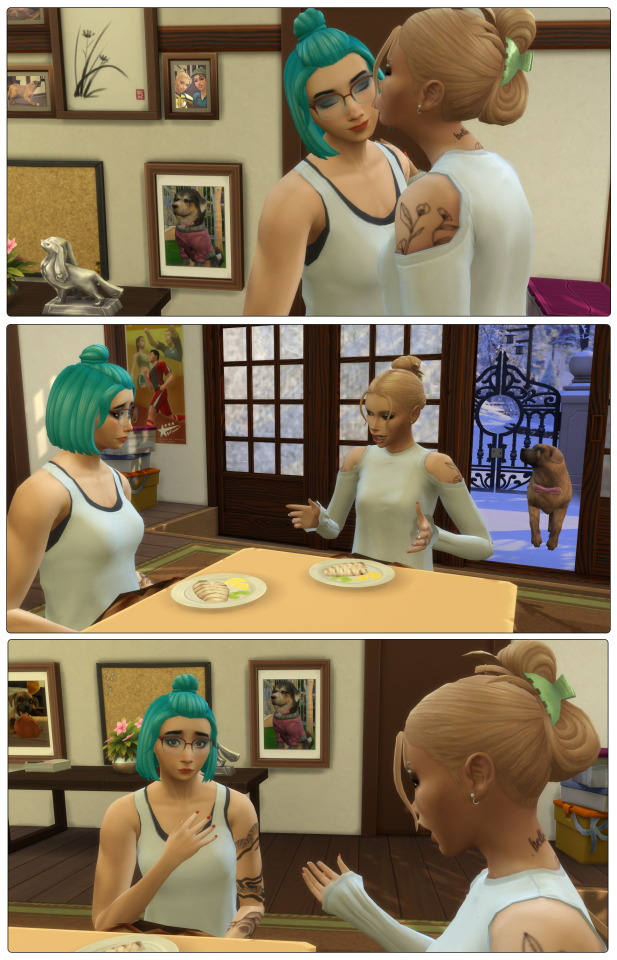
Kaori: Sure we do! We just don’t go. It’s not like we’re going to get pregnant or one of us is sleeping with someone who has a pixel parts infection
Charlie: We don’t need to be trying to get pregnant for our reproductive organs to stuff up and explode
Kaori: *suspiciously* You’re just being gloomy right? Our organs won’t actually explode…
Charlie: Guess the only way for you to find out is to come with me
Kaori: *rolls eyes* Fine. How much will it set us back
Charlie: Don’t worry. All players on the team get health insurance, we’ll be fine, it won’t cost as much

Kaori: Brilliant! We could use the savings on a new couch
Charlie: Umm, I don’t think that’s how savings work. And we hardly ever sit on the couches anyway
Kaori: Doesn’t mean we shouldn’t have nice ones. And I’m not suggesting we use the inheritance on ourselves, but you and I do get income we can spend. You knew you were marrying a shop-a-holic Char, I like nice things
Charlie: Am I included in these nice things
Kaori: Only if you take a shower
Charlie: Oh, she burns!
Kaori: Shut up, you know I still have a fear of fire. I’ll get the dishes, you shower so we can get these medical visits over with
Clover: *barks* Hope I don’t have any medical visits
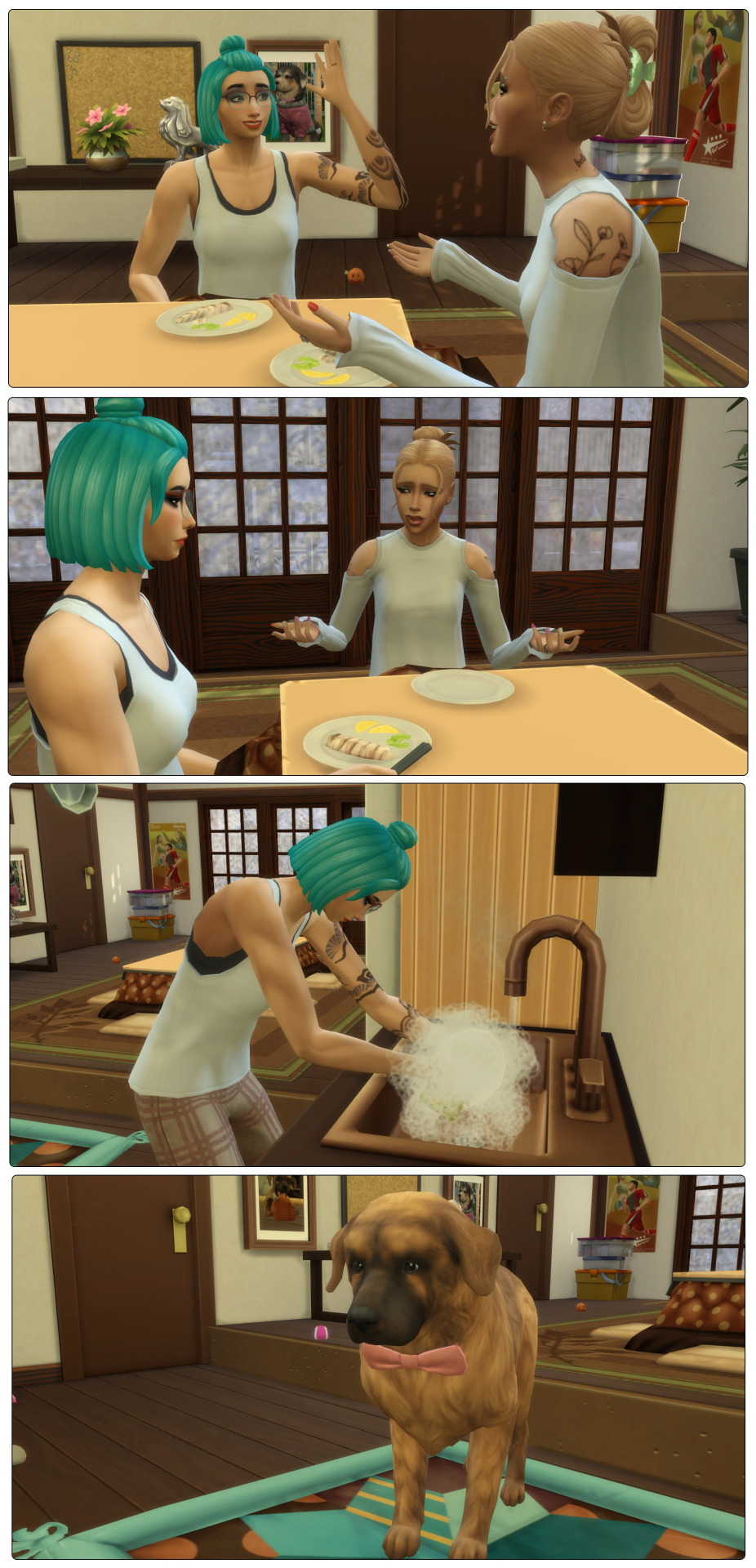
Kaori: We survived!
Charlie: Heck yeah. Now, about what the doctor said…
Kaori: Char she said I’m neurodivergent, it’s not like we need to be worried or sad or whatever
Charlie: I’m gloomy, I can’t help it. Do you want me to go to the psychiatrist with you
Kaori: Nah, I’ll be sweet. Can you get started on the chores for me though?
Charlie: Does gardening count
Kaori: So long as you don’t let Clover track the dirt through the house
Charlie: I won’t. But I know you enjoy vacuuming so… I’ll leave that for you?
Kaori: *laughs* Guilty! Okay, I’ll vacuum when I’m back
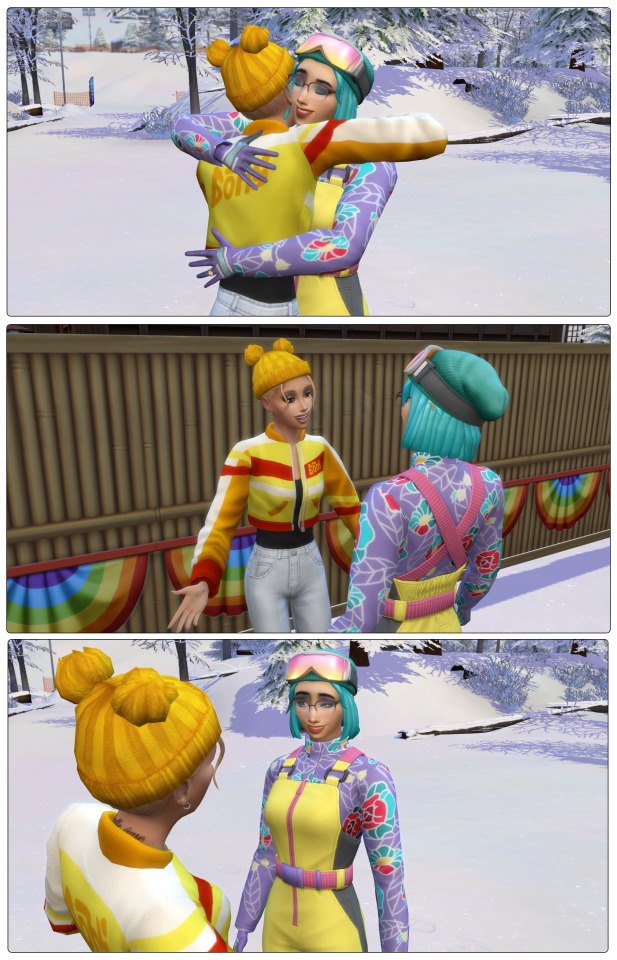
Charlie gets started on her indoor garden. She learned how to garden during her biology degree with Rahul, not that she’d tell her dad that she’d ignored his many attempts to teach her about soil types and fertiliser strengths. She’s calling out to Clover every so often when she realises Clover is barking differently than normal.
Charlie: You better not be inviting around the hound dogs
Clover: *barks to the hound dogs*
Charlie: We’re getting you spayed so don’t even think about it

Kaori: What’s all the noise in here
Charlie: You back? How’d it go
Kaori: Did you say we’re getting this precious angel spayed
Charlie: I did indeed yell that
Clover: *barks in love*
Kaori: But... Charlie... puppies could be so cute!
Charlie: No
Kaori: Why not? You got her and Allie as puppies
Charlie: Over population K. There’s enough strays out there without adding to the surplus
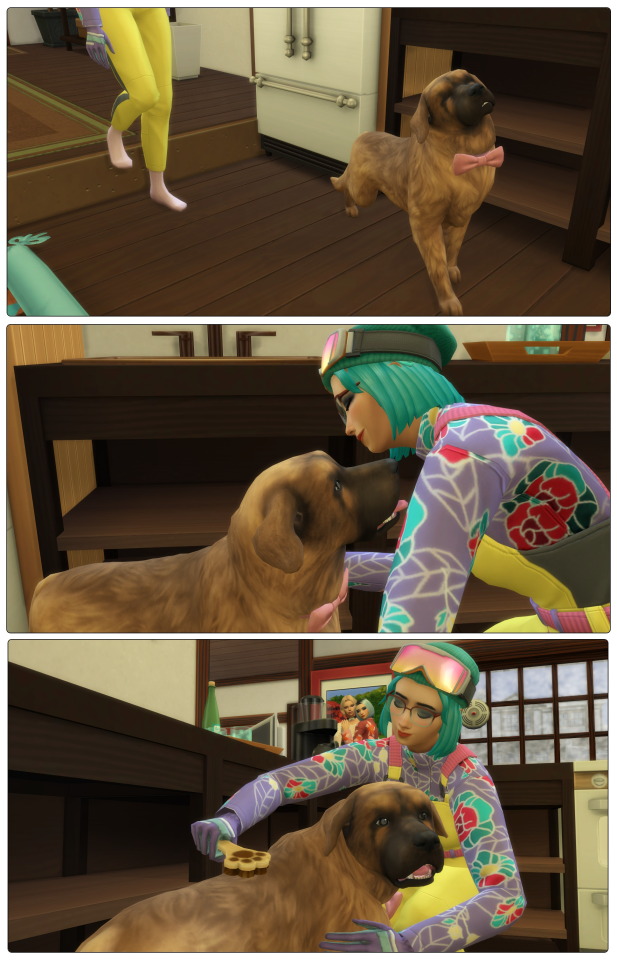
Kaori and Clover go to the garden room where Charlie is fighting a temporary bug invasion.
Kaori: But what if... we kept the puppies
Charlie: *sighs* K, pregnancy is hard and labour is rough. Yes you may end up with cute puppies but think about what Clover would have to go through. It’s not right for us to put her through that when we can get her fixed
Kaori: *pouts* Suppose
Charlie: I don’t want to be pregnant. You don’t want to be pregnant. Why would we make her do something we’re not willing to go through ourselves huh?
Kaori: You’re right, I know you’re right. She just really seems to want to make puppies
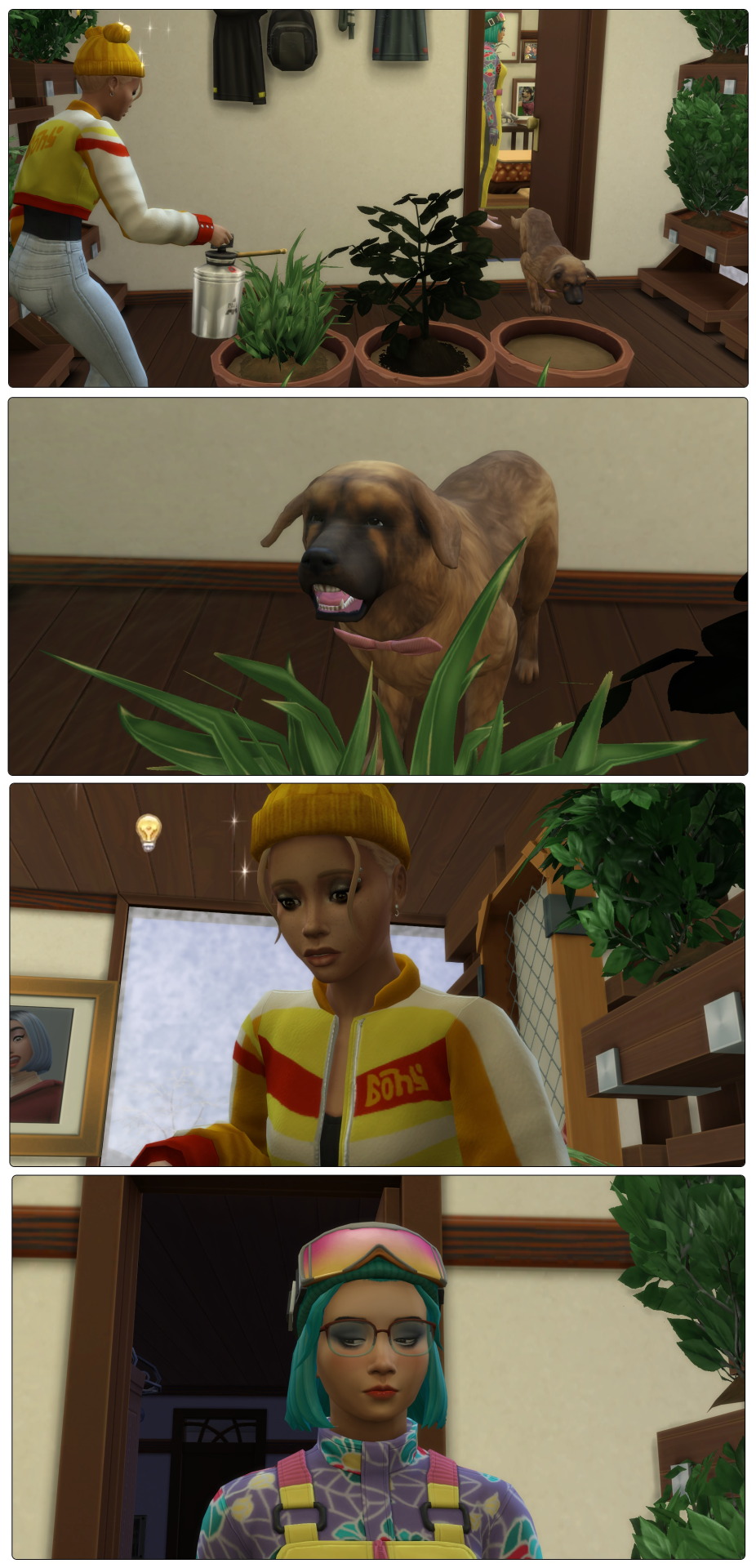
Clover: *barks in love*
Charlie: It’s hormones. Should calm down when she’s fixed. Now what did the psychiatrist say
Kaori: That I have… wait he did write it down somewhere for me…
Clover: *barks in love*
Charlie: Honey pie mummies are talking right now
Kaori: Oh, I kept it on my phone. I have this thing called… Dysgraphia? I think that’s how it’s pronounced
Charlie: I haven’t heard of it before
Kaori: Yeah me neither
Charlie: Do they think we need to be worried at all

Kaori: No. It’s just why I have trouble writing neatly and getting stuff from my head onto paper
Charlie: Did they want you to start anything like meds or tutoring or something
Kaori: Depends on how much I’m bothered. Like I have the film and literature hobby but I enjoy experiencing stories more than creating them you know. I’ll see how I go
With the garden tidied Charlie gets into her uniform and heads off to work.
Kaori: Good luck playing Char! We'll be listening and watching
Charlie: Thanks. Hey Clover, I’ll see you when you have less organs
Clover: *whines*
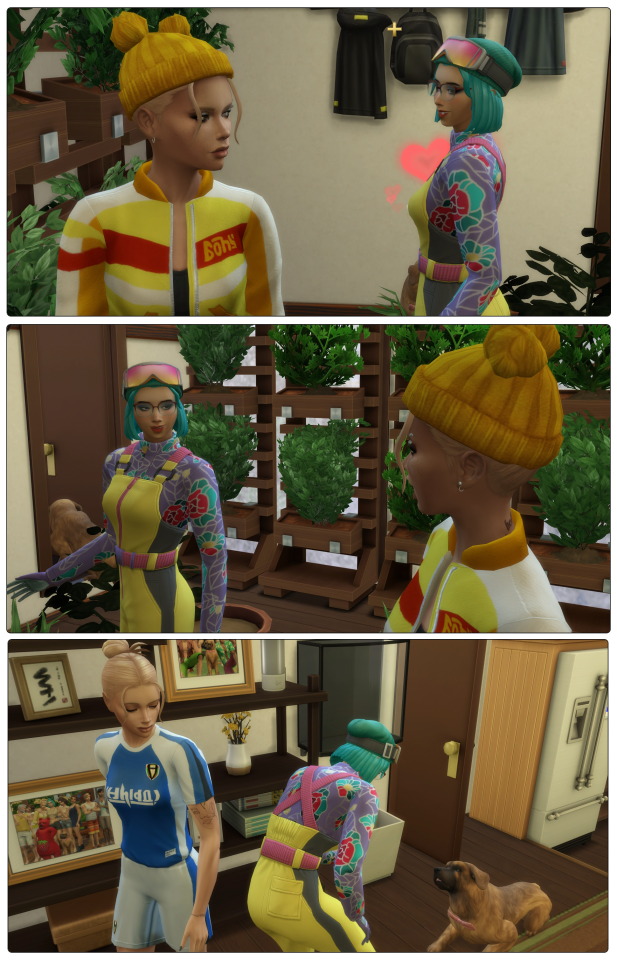
Kaori: Here we are, standard vets. I’ll go sign you in for a spay, come on Clover
Clover: *whines in love*
Kaori: Let’s see… do we have an account here? We should do, we took Allie here after all
Bartholemew A. Bittlebun, Snr.: *meows* Lady you’re in my puddle
Kaori: Spay… spay… spay! Here we go, all signed up
Bartholemew A. Bittlebun, Snr.: *meows* The service here is terrible

Kaori: I’m lucky this screen lights up. Why is it so dark in here?
Clover: *barks* Puddle! I must jump in as tribute to Peanut
Bartholemew A. Bittlebun, Snr.: *meows* Make your own puddle to play in
Clover: *barks* But this one is right here and I need to roll
Bartholemew A. Bittlebun, Snr.: *runs from the scene of the crime*
Justin: Hey lady, your dog is making a mess! All over the floor
Kaori: Maybe you should wait for the vet outside Clover
Bartholemew A. Bittlebun, Snr.: *smirks in victorious cat*

Cora: Clover? Clover?
Clover: *barks* That’s my name, don’t wear it out
Cora: You’re a nice doggy, right
Clover: *barks* Why do you look scared
Sick Non Fox: *barks* Get out of my way!
Clover: *growls* You get out of my way fire feet
Sick Non Fox: Why hasn’t the vet taken you in yet? Do you have rabies
Clover: *growls* I do not have rabies
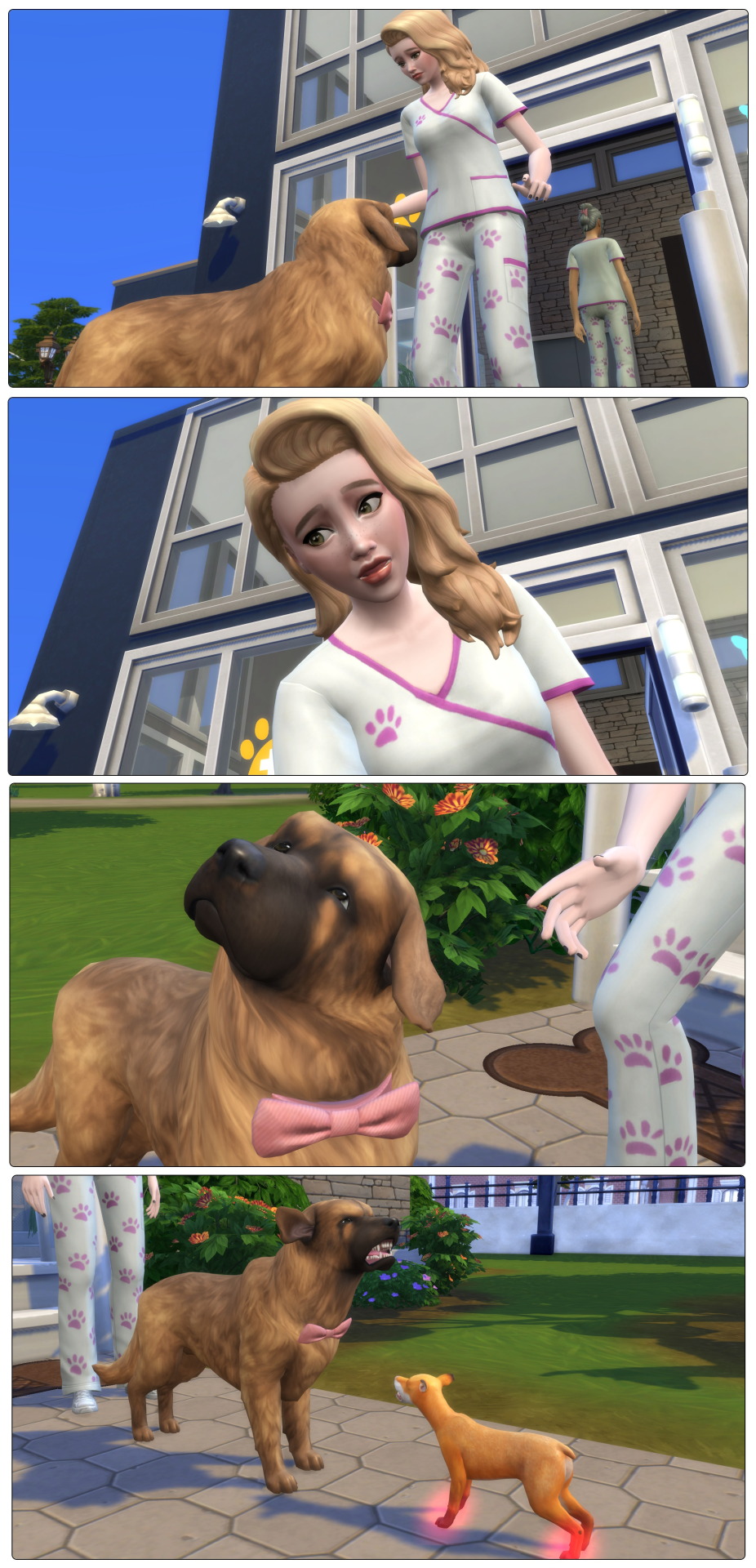
Kaori: So do you have a cat or-
Brant: Three dogs, the youngest one seems to have something wrong with his feet. Luckily we live nearby
Kaori: Oh man I live all the way in Mt Komorebi, but this is pretty much the only vet clinic in the world
Brant: Tell me about it
…
Cora: Nice doggy? Want to play
Clover: *barks* at least that rhymes with spay
Sick Non Fox: You’re getting your organs taken out? Loser. I can breed free
Clover: *growls* I pity any offspring of your ridiculous looking self

Cora: Here we are. If you could just get her to sit on the treadmill
Kaori: Clover, sit. What was the delay?
Cora: Oh, you know, just wanted to check some things
Clover disappears into the machine…
Kaori: What do you mean? What things
Cora: Not to worry. This is my first time doing a spay but I did learn how to tell the difference between the uterus and the bladder
Clover: *whines*
Kaori: Is she okay in there
Cora: She’ll be fine. Now the procedure does fit her with a cone. We recommend *thinks hard* that it stay on for the rest of the day

Kaori takes Clover home feeling less than confident in the nurses abilities but Clover seems fine apart from the cone. Charlie will be working until 9 but the fridge is almost empty so Kaori starts on dinner.
Kaori: I’m sorry we won’t have puppies Clover, they would have been cute. Maybe in a few years mummy will let us get another puppy huh?
Clover: *barks dejectedly*
Kaori: Of course, we could always just go adopt a puppy as a surprise
Clover: *barks questioningly*
Kaori: I know babykins, you’re right. Rescue pets do not make good surprise gifts
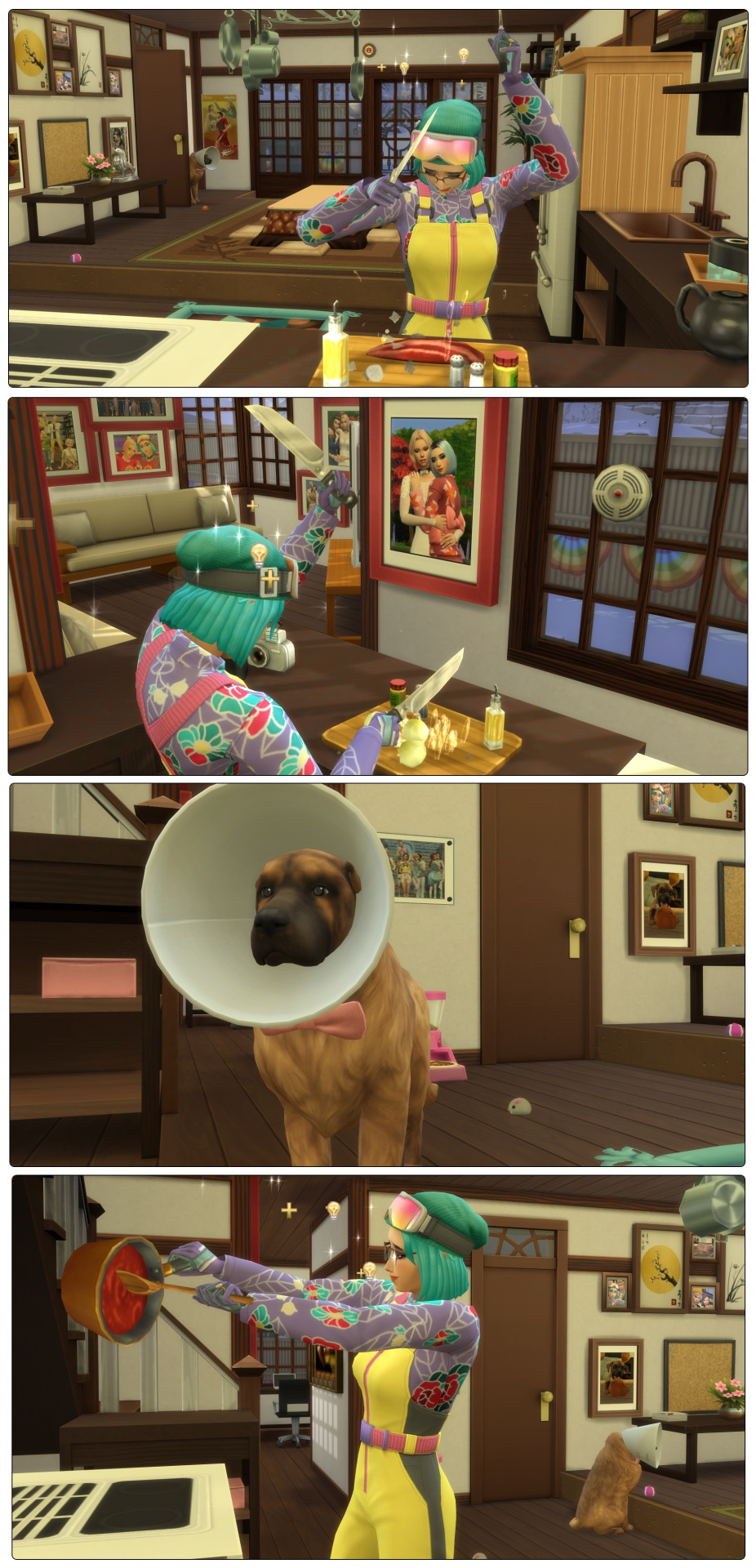
Kaori turns on the radio while she eats so she can tune in to Charlie’s game. She’ll watch it properly when she’s eaten but she likes to catch the start. It’s a rough game for Charlie’s team, they don’t win, and Charlie gets subbed out ten minutes before then end. She returns home gloomier than usual.
Kaori: Do you want a massage
Charlie: You watched the game huh
Kaori: I did
Charlie: I hate when coach subs me out at the end. I’m the best on the team for the penalty shootouts
Kaori: I suppose you can’t win them all
Charlie: This stupid reporter-
Kaori: Hey, have some food while we talk. You look pretty wiped out
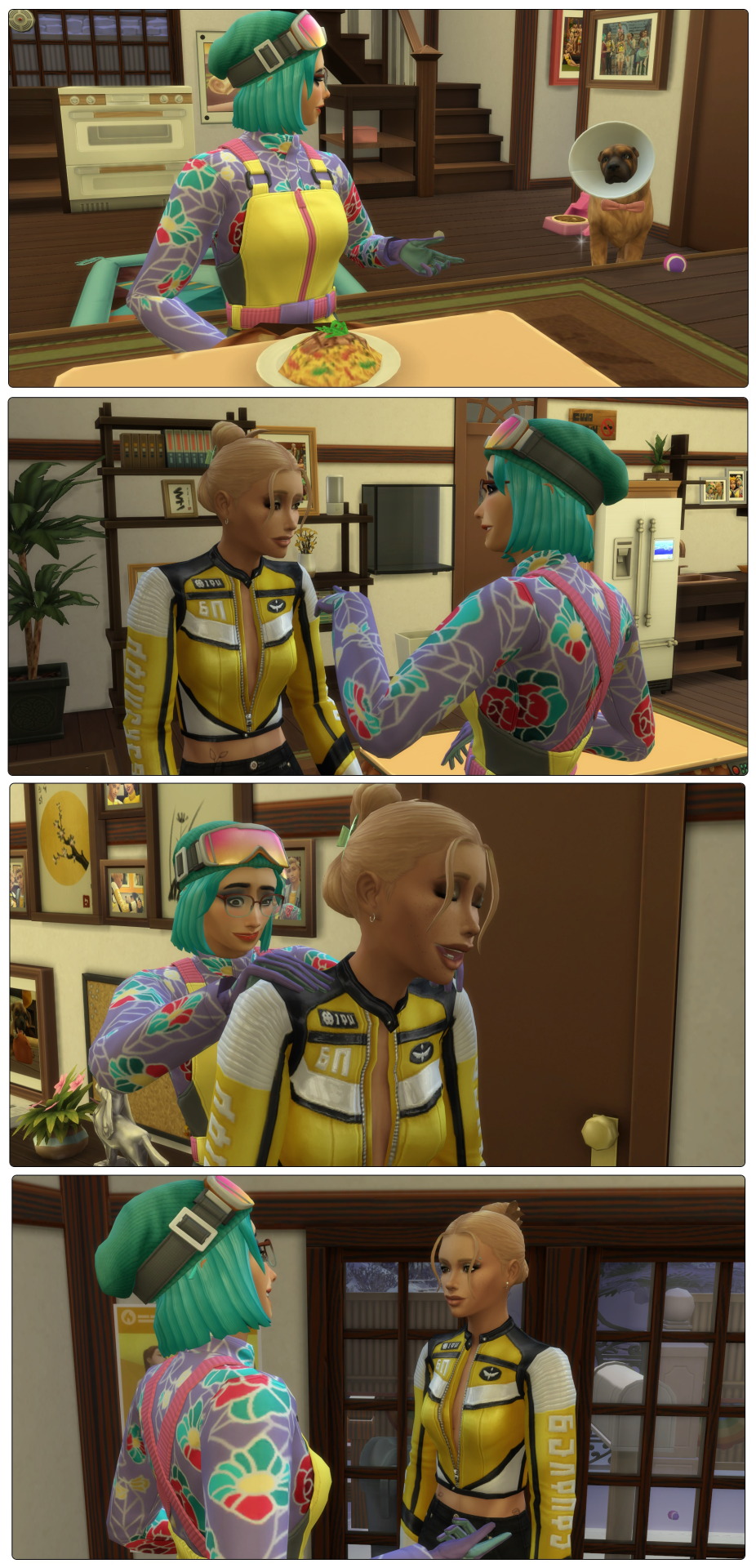
Charlie: You left me the last of the Pho?
Kaori: I had to cook so I figured I’d let you have it
Charlie: Aww thanks K. You’re sweet
Kaori: Now you mentioned reporter
Charlie: *sighs* So it’s post match press and this guy calls the loss one of the worst ever to happen in soccer. Which I get, it was a rough end. But he was asking me who was responsible? Did the dude not see I wasn’t even on the pitch for the end?
Kaori: Did you tell him off
Charlie: I thought about it, but I didn’t want to throw coach under the bus. Then she’d have even more reason to bench me. So I spouted some nonsense about teamwork. I swear they target me with the tricky questions because they know I’m gloomy and they’re searching for a soundbite
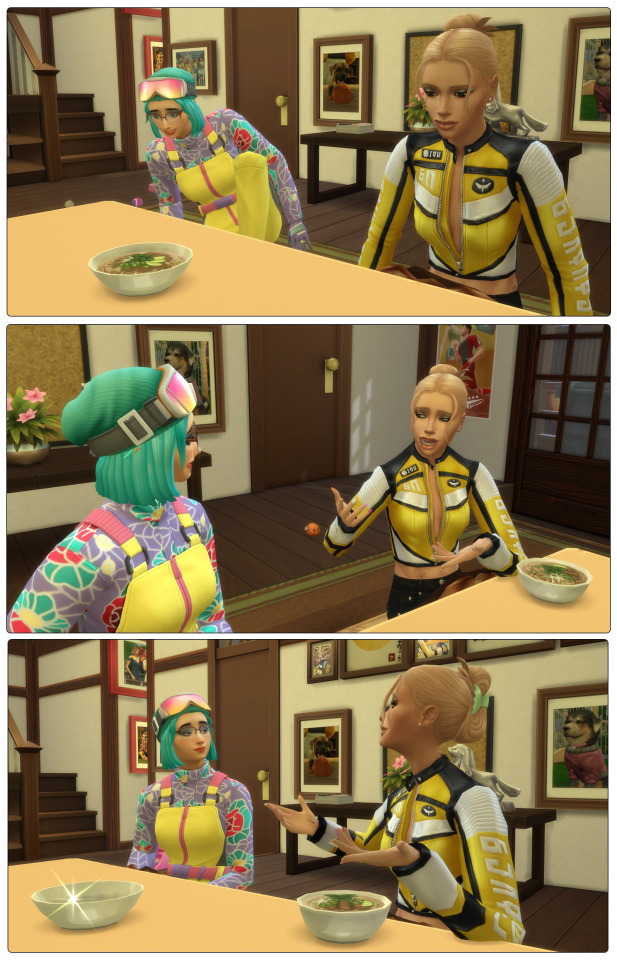
Kaori: Come here, I love you and your gloominess. It keeps me and my cheerfulness grounded
Charlie: *sighs* I suppose so. I guess I should do the dishes
Kaori: No, I got them. I think somebody wants their cone off
Charlie: Oh Clover, Honey pie? Who wants to be free again?
Clover: *barks* Have mercy on me
Charlie: Does my brave girl need a hug, huh? Do you need a hug?
The tired trio head to the bedroom together and fall asleep.

Previous (Foster) ... Next
#sims 4#the sims 4#the sims#simblr#R0809#ChangingPlumbobStorytime#NishidakeHousehold#CharlieNishidake#KaoriNishidake#SoundCloud
17 notes
·
View notes
Text
DEMETER
Although Demeter is primarily known as the Greek goddess of the harvest, agriculture, and fertility, there is also another connection between her and bees, which I wanted to explore further and is why I chose to call this piece ‘Mother of Bees’.
So, while Demeter is not exclusively known as the goddess of bees, she is associated with them in the context of her role in teaching agricultural practices to humanity, practices which have been abandoned in the present day. I believe Demeter in her aspect of Mother of Bees teaches us the lesson of how we can nurture our food crops in synch with the natural world, not against it. Bees are an excellent example pf symbiotic survival. Through the process of pollination, they nurture other species in order to preserve their own. The aim of our own lives should be the same, to live in harmony with and have respect for all other forms of life on our planet, so all can thrive and grow.
This is a much needed lesson as we continue to plummet into the 6th known extinction event of this planet. Presently we are taught to dominate and mould the environment to our specific use. This is evident in the bio diverse deserts of industrial mono crop farming dependent on pesticides and fertilisers to gain better yields and large scale factory animal husbandry practices which desiccate the earth and pollute water sources. This approach to feeding ourselves as a species at the cost of all other life will after only a few cycles collapse the whole food chain and all life will suffer. The humble Bee shows us another way to live, in symbiosis with the wider living world, so all will thrive and grow.
Demeter is more than the goddess of the grain and bounty of the harvest to me. As Mother of Bees she is a lesson on life and how to live it. Her bees teach us that by valuing and protecting all life you in turn protect your own life, we do not live in isolation, everything is interconnected and interdependent.

9 notes
·
View notes
Text
Nonsense continues apace. I've already got almost 8k of this down, and it's GROWING. Oh God.
There was a ballet going on above Crowley’s head. Well, a ballet class. Judging by their thunderous footfalls, the kids currently using the upstairs room of the church hall were going to need a lot more lessons before they mastered the butterfly grace of professional dancers. Crowley had the downstairs room, and the use of an overhead projector. Shaking off a sense of déjà vu, she adjusted her first slide and turned to face her audience.
“Right,” she said, whipping out an ebony pointer leftover from her days as ‘Mr Harrison’. “Let me tell you about plants. They have three needs – light, water, and taking advantage of your generosity. Biggest one is the third – taking the pi…taking advantage. For some of them? It’s never enough. You can give a plant all the light and water in the world. Fertiliser, too. You can even bust out the Baby Bio on them, but they will give you no quarter.” She smacked down the pointer for emphasis. “It’s not enough for them. They won’t be satisfied until they’ve got into your heads. How, you ask? Well, I’ll tell you. They will wilt. They will get leaf spots. They will pretend – very convincingly, sometimes – to be dead. These are the ways in which plants will attempt to emotionally manipulate you into thinking you’re not taking proper care of them. Even when you are. Your job, as gardeners, is to never give them an inch. Is that clear?”
There was a faint rumble of assent, but it was mostly drowned out from above by the elephantine thuds of small children hitting the floor to the strains of Prokofiev’s Peter and the Wolf.
“Look to your right,” said Crowley. “Look to your left, because one of you won’t be here by the end of this gardening course. It is a war out there. Understand?”
The troops nodded. Pathetic.
“‘Yes, Miss’,” said Crowley.
“Yes, Miss.”
“Good. Louder.”
“Yes, Miss!”
“Better,” said Crowley. “Any questions?”
A hand went up in the back row. “Can I go to the toilet, please?”
Crowley sagged gently in despair. “Can you hold it?”
The little girl – a tiny sprout of a thing – shook her head. “It’s a poo, Miss.”
“Okay. Off you go.” Crowley sighed. “No, not that way. They’re still re-tiling in there. You’ll have to go to the ones in the car park. You…are you her brother? Can you take her to the toilet? Thank you. Right. Any other questions? Plant related this time, please.”
10 notes
·
View notes
Note
what if link and mipha adopt a kid and then like 3/4 years later they have a bio kid because they are so different bio kid would have some health problem probably leg movement because hylain and zoras legs are vastly different. older sister is totally 100% not jealous at all nope not one bit and link has a conversation with the older kid that she is not inferior to her sibling they just need special attention and that him and mipha love her very much and just shdudhfhjfjdjdnd
This is an interesting idea!!! I personally hc that Link and Mipha's biology is to different to be able to...uh... Fertilise an egg, or make a baby, but it's really cute nonetheless!!!
I think their daughter would be quite jealous when it comes to other kids xD sorry for not having any art for this one, I just couldn't think of how to draw something for this!
Thank you for the ask!!!
14 notes
·
View notes
Note
you don't know what a gamete is??? are you lying about your age or did you just fail hs bio..... 🤔🤔 i feel like any adult seeing the term gamete, even if they don't remember what it is, would at least think "oh yah i remember that term from school lemme google it real quick so i don't embarrass myself" like are you 12 be honest
Helloo!! This is too nice, thank you for this lovely ask.
You're a cunt and i wish nothing but hardships and evilness upon you forever and ever.
What makes you (and several other people) believe it's ok or warranted or in any way appropriate to talk to random strangers on the internet like this? I feel like you're the one who missed some lessons in basic human decency.
The tags on any given post do not reflect my Entire thoughts on the matter. An example: from context, i was very much able to understand what a gamete is. There's only so many things in a human body that can be fertilised.
I did fine in "hs bio" you absolute asshole
Actually the age in my bio rn is wrong. I turned 25 yesterday, happy bday to me 🎉 Suck it.
Has it ever occurred to you that... Not everyone is USAmerican/a native english speaker? That's a rhetoric question btw; it warrants no response. I know it Hasn't occurred to you because you seem to be a self-centered fuckwit
The German word for gamete is Eizelle. As you may find, these two words have very little in common, unlike other words, which share a similar origin, like, for example, idiot. The German for idiot is Idiot.
The post you're coming at me for has 145 notes. I dont know how anyone could get upset at someone's (completely inoffensive) TAGS?? on a 145 note post. You're insane
Fuck off
#gamete#oh and in case it wasnt clear lol#my tags were a roundabout way of saying that jkr speaks about women in brain-scramblingly convoluted ways#if i stepped on your toes w any of that . ok#i will do it again#get fucked#quip#ask
6 notes
·
View notes
Photo

Recent studies suggest global food production is responsible for one-third of all planet-heating emissions, with the use of animals for meat accounting for twice the pollution of producing plant-based foods. Haarlem, which lies to the west of Amsterdam and has a population of about 160,000, will enact the prohibition from 2024 after meat was added to a list of products deemed to contribute to the climate crisis.
The ban also covers holiday flights, fossil fuels and cars that run on fossil fuels. Adverts will not be allowed on Haarlem’s buses, shelters and screens in public spaces, prompting complaints from the meat sector that the municipality is “going too far in telling people what’s best for them”. Forests that absorb carbon dioxide are felled for the grazing of animals while fertilisers used for growing their feed are rich in nitrogen, which can contribute to air and water pollution, climate change and ozone depletion. Livestock also produces large quantities of methane, a powerful greenhouse gas. Source: The Guardian (link in bio) #climatechange #goodnews #progress https://www.instagram.com/p/Cike7jcLWeB/?igshid=NGJjMDIxMWI=
37 notes
·
View notes
Note
For logical consistency reasons, it's weird, I can't stand stories where a monster puts their eggs (as in ova) and sperm in the same place/hole in somebody. It's just an unsound evolutionary strategy, that's self-fertilization, which is basically inbreeding with yourself and leads to genetic problems when done regularly. If you're just using somebody just put clonal embryos in eggs in them instead, instead of compounding recessive genetic problems (Monsterfucking Bio Pet Peeve Rant 1/2)
(Monsterfucking Bio Pet Peeve Rant 2/2) Instead of putting sperm + eggs (as in ova) in the same hole of someone, better monster breeding strategy ideas would be: (1) Have egg-shaped spermatophore packages put in someone to fertilize their ova (and also make them produce shelled eggs once knocked up ?) ... or (2) Milk someone who makes sperm and then shove the eggs (ova) fertilized with the fuckee's sperm back into the fuckee's hole (sort of seahorse style). (Human/Monster Hybridization = sexier)
Whenever I have a critter doing fertilisation and egg implantation from the same place, I always go w the assumption they collected the sperm from another member of their own species rather making it themselves. That they aren't safely able to carry a clutch themself, so fertilising it 'in house' so to speak would be dangerous, whereas carrying them stored seperately until you can shove em in a host and be like ok now u get to be a womb whilst these grow rapidly is a more sound 'don't die lol' strategy.
33 notes
·
View notes
Text
Food Forests: Pathways to Sustainable Agriculture
What is a Food Forest?
Food forests are agricultural systems where numerous diverse food crops are grown within any given patch. They’re called food ‘forests’ and not food ‘farms’ because they are designed to look, function and feel like forests.
Why forests? For the simple reason that they are epitomes of natural ecosystems. They are resilient, adapt to changing weather conditions, and need external support. All forest elements - trees, vines, shrubs, animals, insects, even soil and water - speak a common language and rely on each other to survive and grow. This makes the forest ecosystem self-sustaining.
Characteristics of a Food Forest
Food forests are designed to mimic the processes and patterns of nature. Naturally, they will include all the characteristics of an actual forest.
Lush greens wherever the eye can see
Several, intertwined, dense layers of trees, shrubs, vines and ground covers
Diversity of plant and animal species
Coexistence and inclusivity of all life forms
Three-dimensional growth of life, including the underground
Presence of several micro-ecosystems of varying scales within the forest
The biggest visual characteristic of a food forest, however, is that it looks drastically different from modern monoculture farming. Typically, in a food forest, no two patches will look the same. In addition, the plants grown are primarily edibles.
But unlike forests, food forests do not grow on their own. Well, not initially. Permaculture farming methods are applied to design a food forest. Deep land studies and analyses dictate the best course of action for the land that is in tune with the landowner’s aspirations for their ‘food garden’.
How do Food Forests Aid Sustainable Agriculture?
Modern agriculture has been suffering due to climate change. It is also heavily market-dependent. Hence farmers are forced to grow more on less land. This leads to the excess use of fertilisers that ultimately degenerate the soil.
Food forests, on the other hand, make use of permaculture farming principles. It is a regenerative approach to farming where all activities work towards restoring the land’s nutrients and capacity. Albeit a slow process, it guarantees self-sustenance over a few years of nurturing. As they say, good things take time!
This approach to farming provides a promising solution to sustainable agriculture. Here’s why food forests can be the key.
1.Regeneration of Soil Health
A curated selection of native species eliminates the need for using fertilisers. Furthermore, plants of various sizes can help strengthen the root network. Groundcover plants/ low-growing shrubs protect the soil from sun and harsh weather. This prevents soil erosion and restores the carbon in it.
2.Inclusion of All Life Forms
Just like in the jungle, several species of animals and plants coexist in a food forest. Any design that threatens the life of another specie is modified/eliminated. Animal- friendly designs like bio-fencing and temporary shelters are encouraged.
3.Efficiency of Resources
Food forest designs include smart water channeling, relying on renewable energy for power and building permanent structures from local materials. This reduces the carbon footprint too.
4.Reduced Need for External Inputs
When there’s a goldmine of agricultural inputs on your own land, why look outside? Planting species that act as natural pest controls, and using the waste from one facet as a valuable resource in the other are just some of the many ways food forests reduce the need for external inputs, slowly inching towards complete self-sufficiency.
Considering all the benefits food forests offer, In India, we are seeing growth of startups which manage such food forests and offer managed farmlands near Mumbai and other metro cities to people looking to live an alternative lifestyle. In the coming years we hope to see this trend growing further, drawing people away from the concrete jungles of the urban centers.
20 notes
·
View notes
Note
Have you read The evolutionary origins of patriarchy by Barbara Smuts
Just read it, here are my thoughts and some quotes I thought were interesting:
If anyone's interested, I found it here (it's just 17 pages)
TLDR: Her hypotheses are interesting and I think can work within feminist analysis: That ecologically based (though she mentions there is not enough research into why prehistoric humans were patrilocal) patrilocality dispersed women from their kin, that males learned to form male-male bonds against women, that men gained control over resources, that women can benefit reproductively or socially from actions that increase male control. She explains her points well and does not suggest essentialism or determinism as resulting from evolution or the idea that men are biologically programmed to control women and that women are biologically programmed to be subordinate. Discusses the wide variety of ways men behave within cultures and saying that this isn't the result of different genes.
"Elimination of the common misconception that adaptive explanations imply genetic determinism allows one to appreciate that, far from being "fixed" traits, many adaptations are exquisitely sensitive to environmental variation. Behavioral adaptations, in particular, often represent flexible responses to variable environments (West-Eberhard 1987). Humans are especially sensitive to both past experience and the present environment because natural selection favored the evolution of brains that specialize in flexible responsiveness to the extremely diverse and variable conditions in which humans live."
I find it an interesting article, for the way it describes for instance evolutionary traits not necessarily meaning fixed, immutable traits and her emphasis on the environment's importance when considering evolutionary behaviour.
One of my main gripes with classic evolutionary biology is the whole 'Women are choosy and vulnerable and need male resources and protection for their young, while men have all the power and it is in their best interests to just go around fertilising women. This conflict is mitigated by men offering resources and protection to women when they father children.' because it usually results in claiming marriage and paternity is ultimately to women's benefit and stuff like that and that it is the alternative, men being sexually coercive, that is the threat. When evol biologists talk about "fixing evolutionary based rape" they always end up talking about the latter and ignoring that their very conception of women being inherently vulnerable and men inherently with power and connections, and women being forced to bear children for men willing to expend those resources, is coercive as well. Like the whole "patriarchy happened because men's interests overrode women's" is still very much ignoring that many evol psych/bios' definitions of men and women's "interests" coinciding is literally patriarchy.
"In rhesus monkeys, discussed earlier, females form strong, life-long bonds with their female kin, and females cooperate to protect their female relatives against male aggression (e.g.,Chapais 1981)."
It makes me interested to see how much research on this has been done in the intevening years. The last thing I read on evol psych written recently (and by a respected scholar) was the most misogynistic bullshit I had ever seen which was arguing that women evolved against becoming engineers.
"Nevertheless, it is likely that the important female contribution to subsistence in most foraging and simple farming economies (Schlegel and Barry 1986) allowed females to retain some economic power and placed limits on male control over women. However, with the advent of intensive agriculture and animal husbandry, women, by-and-large, lost control over the fruits of their labors (Lerner 1986; Sacks 1975; Schlegel and Barry 1986). Foraging and nomadic slash-and-bum horticulture require vast areas of land and mobile females, making it more difficult for men to control women's resource base and to restrict women's movements. However, when women's labor is restricted to a relatively small plot of land, as in intensive agriculture, or is restricted primarily to the house-hold compound, as in animal husbandry, it is easier for men to control both the resource-base upon which women depend for subsistence and women's daily movements."
23 notes
·
View notes
Text
At a societal level, most people grasp the importance of plants to their lives and the ecosystems they inhabit. The success of humans as a species is inextricably interwoven with the success of plant life on Earth. Without the growth of ancient forests, the biosphere in which we live would not have enough oxygen-rich air for humans to have evolved. Without the cultivation of plants for food, humans could not have settled, built shelters and developed rich and diverse cultures. In practical terms, too, building with plants makes a lot of sense. They grow back and are relatively easy to cultivate, harvest and process into useful materials. Their inherent fibrous structures give our buildings integrity. Trees, processed into timber, work extremely well in both compression and tension. Hollow straws and grasses hold air within them, making them great insulators. The lignin in many different plants can act as a natural binder when heated, meaning that you can essentially squash them, heat them and they stick together into useful sheet materials. Mixed with different binders like clay and lime, they can be given resistance to fire, insects and mould. Bio-based materials are also hygroscopic – meaning that they hold and release moisture. The fact that they can absorb humidity from a room helps to regulate damp and prevent mould from growing. That they are moisture permeable means that water vapour trapped in walls, from rain ingress or generated through leaks, always has somewhere to go. Contemporary buildings, on the other hand, are essentially wrapped in plastic sheets, trapping in moisture and resulting in poor indoor air quality.
Some of the best examples of bio-based buildings are hiding in plain sight in villages, towns and cities across the globe, having withstood decades, sometimes centuries of wear and tear. Timber-framed barns, reinforced with hazel wattle and clay daub can be found dotted across the British countryside. The technique of cob building, using loadbearing clay and straw, was very commonly used in the south-west of England in the 19th century, and many of those cob buildings still stand in Devon and Cornwall today. They are finished in a lime render and look from the outside like any other stone or brick building.
That these techniques have not become more widespread is, at first glance, surprising. The local materials and skills used to build with them were relatively low cost, and when well maintained, extremely durable. The critical thing about these materials, however, is how they were intrinsically linked to land, and specific geographies or bioregions. Industrialisation brought with it a change in agricultural practices and land ownership. Bio-based materials were conventionally derived from agricultural waste; long wheat straw was for example used for thatching, until modern chemical fertilisers that help the wheat grow more quickly weakened the structure of the straw, making it too brittle. Water reed, also used in thatching and as a render substrate, was once abundant in wetlands, but these were drained over the course of the 19th century to develop more arable farmland, cutting by approximately 90 per cent the amount of land on which the reed could grow.
Industrialisation also brought about the development of contemporary insulations, designed initially to prevent energy loss from high-energy machinery and factory spaces. Materials such as concrete and steel, which enabled the quick assembly of spaces of production, ultimately sought markets in domestic construction too. These materials were produced at an unprecedented scale and advertised as technologically advanced, in need of little or no maintenance: symbols of a bright future in which being cold, damp and living with fire risk were a thing of the past. And as these materials became more and more popular, regulatory frameworks began to be designed around them, with lawmakers falling victim to aggressive lobbying and marketing campaigns. Today, testing and certification, mortgages and insurances in the UK and beyond are generally designed around contemporary building systems, and materials which have proven their efficacy over decades of service are considered risky, fringe and ultimately more costly.
The petrochemical and mineral materials we have been building with since the Industrial Revolution require an enormous amount of energy to be extracted and processed. The cement industry, for example, is responsible for about eight per cent of planet-warming carbon dioxide emissions – far more than global carbon emissions from aviation. We cannot continue to build using materials that generate enormous outflows of emissions and have to be shipped across great distances. We need to use materials that are lower in embodied carbon: bio-based materials, derived from plants which can regenerate sustainably and sequester carbon into our buildings.
125 notes
·
View notes